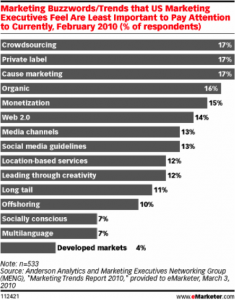At a recent TEDx Conference, Paul Lewis gave a compelling talk titled “Crowdsourcing in the News”. In it, Lewis spoke of two stories that highlighted the future of journalism: a social arena where stories become online magnets and news is essentially coproduced. Lewis argues that this “citizen journalism” is highly beneficial as it generates a new layer of accountability in our world through witnessing, recording, and sharing. Although I agree with Lewis’ argument, one needn’t look too far to see the dark side of crowdsourcing. In the aftermath of Vancouver’s Stanley Cup riots, public shaming sites exploded with stories accusing bystanders of being involved. Don’t get me wrong, I think all those who took part deserve to be punished; however, I also believe that one is innocent until proven guilty. Therein lies the problem with crowdsourcing. Without any control over such user-generated content, we face the same credibility issues that crowdsourcing is meant to overcome. Although crowdsourcing in the news may seem to have little relevance to the world of marketing, I would argue that some interesting parallels exist.
The article “Crowdsourcing and Its Application in Marketing Activities” by Paul Whitla does a good job highlighting the merits of crowdsourcing for marketing purposes. These advantages, as noted in the article, are mainly to do with having access to a very large community of workers with diverse sets of skills and expertise who are willing to do the work in a short period of time and at a fraction of the cost. These advantages, however, do little to explain the overwhelming reluctance by marketers to embrace the power of crowdsourcing. As seen in the graph below, many marketing execs feel it is yet another fad.

This is not to say that all marketers avoid crowdsourcing. The article discusses three areas in marketing where crowdsourcing is used: new product development, market research, and advertising. Obtaining information from customers is nothing new, especially in new product development. However, crowdsourcing has enabled companies to obtain feedback from a much larger group of consumers, to interact with these consumers directly, and to create more targeted and focused questions. As seen below, the use of crowdsourcing is much more apparent in the early stages of new product development where ideas are generated and developed.

This supports the theory that divergent thinking should precede convergent thinking and, as such, getting the input from end-users can only help cast out a bigger net and generate more diverse ideas. This “outside-in” approach to creation helps companies realize ways to produce mutual value.
When it comes to market research, crowdsourcing is a cost effective way to acquire information from a large group of consumers. Although it is relatively easy to obtain this information, it is important for marketers to focus their questions on generating specific and appropriate responses. Information overload is almost as difficult to sort through, as is having not enough information at all. The implications for marketers is that crowdsourcing should be used as a tool, rather than a be-all and end-all.
In advertising and promotion, crowdsourcing is more widely used in smaller firms that are financially restricted when developing new advertising and promotional initiatives. However, larger firms have started to embrace the phenomena when seeking to appeal to a younger audience. Frito-Lay generated buzz when the company ran a competition to attract end-users to create their own advertisements on the company’s behalf. Frito-Lay’s efforts to engage end-users resulted in a campaign that was very effective in resonating with their target consumers.
Although many believe the crowdsourcing phenomena will eventually disappear, no one can deny the power it has to engage consumers. It is hard to know where the market is headed, as industry leaders can disappear in the blink of an eye (MySpace), but it is clear that marketers should embrace crowdsourcing, just as Lewis argues that journalists should embrace it. Having said that, there are a few implications for marketers when using crowdsourcing effectively for marketing activities.
Marketers must understand that crowdsourcing is best used as a complimentary activity, rather than a replacement to the role agencies play in marketing. Using crowdsourcing on its own without any control mechanisms creates similar problems to what was highlighted in Lewis’ argument. However, by asking the right questions to the right people and understanding how to interpret the information received, marketers can harness the power of the crowd to fuel innovation. Marketers should take more risks at the expense of losing control. Customer loyalty is about engaging customers and acknowledging their voices, and by having a two-way conversation, companies are better positioned to create shared value. As was highlighted in Lewis’ talk, the power of crowdsourcing can be exploited if a company can effectively weed out irrelevant information. Through filtering and aggregation, the credibility issues disappear and companies can realize the true potential of crowdsourcing.
Finally, for companies who are involved in CSR initiatives, research has shown that crowdsourcing can be extremely effective for increasing customer engagement. By doing things that are meaningful to customers, a company can build relationships with a wide range of end-users and provide more compelling ways for people to get involved. As highlighted below, crowdsourcing can generate new perspectives and diverse opinions when it comes to a company’s CSR efforts.

Lewis argues that the future of journalism will be co-produced and that it will bring a new level of accountability to the news. I would argue that the same is true for marketing. Companies will utilize a more outside-in approach for content creation, resulting in a stronger and more influential message. Yet, crowdsourcing will only become an effective tool if marketers learn to control such diverse content.
Sources
Paul Lewis. “Crowdsourcing the News”. TEDxThessaloniki. November 2011.
Paul Verna. “User-Generated Content: More Popular than Profitable”. eMarketer. January 2009.
Paul Whitla. “Crowdsourcing and Its Application in Marketing Activities”. Dept of Marketing and International Business, Lingnan University. 2008.



